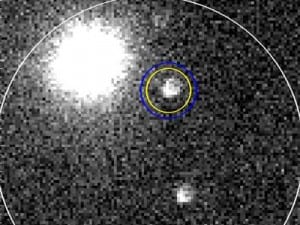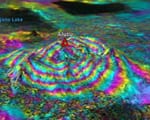To put the age of the latest discovery into context, scientists believe the Big Bang occurred 13.81 billion years ago.
The news service Global Post covered the astronomy research of physicist Robert Kehoe, SMU professor, and two graduate students in the SMU Department of Physics, Farley Ferrante and Govinda Dhungana.
The astronomy team in May reported observation of intense light from the enormous explosion of a star more than 12 billion years ago — shortly after the Big Bang — that recently reached Earth and was visible in the sky.
Known as a gamma-ray burst, light from the rare, high-energy explosion traveled for 12.1 billion years before it was detected and observed by a telescope, ROTSE-IIIb, owned by SMU.
Gamma-ray bursts are believed to be the catastrophic collapse of a star at the end of its life. SMU physicists report that their telescope was the first on the ground to observe the burst and to capture an image.
Recorded as GRB 140419A by NASA’s Gamma-ray Coordinates Network, the burst was spotted at 11 p.m. April 19 by SMU’s robotic telescope at the McDonald Observatory in the Davis Mountains of West Texas.
Global Post reporter Sarah Wolfe reported the news in his article “Light from this 12-billion-year-old explosion just reached Earth.”
EXCERPT:
By Sarah Wolfe
Global PostIt took 12 billion years, but light from a massive explosion that occurred shortly after the Big Bang has just reached Earth.
The rare gamma-ray burst could help scientists understand more about the early universe.
Recorded as GRB 140423A, the explosion was first observed in April by the telescope Rotse-IIIB at an observatory in western Texas owned by Southern Methodist University.
The area of the explosion’s peak afterglow, circled in blue and yellow, can be seen in the image above. A bright star sits to its left.
Gamma-ray bursts are believed to be the catastrophic collapse of a star at the end of its life.
“As NASA points out, gamma-ray bursts are the most powerful explosions in the universe since the Big Bang,” Farley Ferrante, a graduate student at Southern Methodist University who monitored the explosions with astronomers in Hawaii and Turkey, said in a release from the university.
“These bursts release more energy in 10 seconds than our Earth’s sun during its entire expected lifespan of 10 billion years.”
Scientists weren’t even able to detect visual light from gamma-ray bursts until technology improved in the late 1990s. Gamma rays have the shortest wavelengths and can only be seen using special detectors.
Follow SMUResearch.com on Twitter.
For more information, www.smuresearch.com.
SMU is a nationally ranked private university in Dallas founded 100 years ago. Today, SMU enrolls nearly 11,000 students who benefit from the academic opportunities and international reach of seven degree-granting schools. For more information see www.smu.edu.
SMU has an uplink facility located on campus for live TV, radio, or online interviews. To speak with an SMU expert or book an SMU guest in the studio, call SMU News & Communications at 214-768-7650.


 Low IQ students learn to read at 1st-grade level after persistent, intensive instruction
Low IQ students learn to read at 1st-grade level after persistent, intensive instruction Richest marine reptile fossil bed along Africa’s South Atlantic coast is dated at 71.5 mya
Richest marine reptile fossil bed along Africa’s South Atlantic coast is dated at 71.5 mya Satellite view of volcanoes finds the link between ground deformation and eruption
Satellite view of volcanoes finds the link between ground deformation and eruption Comet theory false; doesn’t explain cold snap at the end of the Ice Age, Clovis changes or mass animal extinction
Comet theory false; doesn’t explain cold snap at the end of the Ice Age, Clovis changes or mass animal extinction